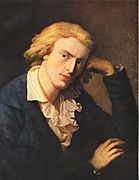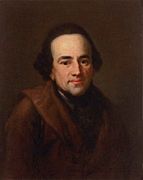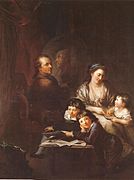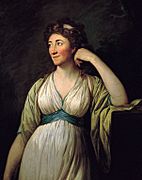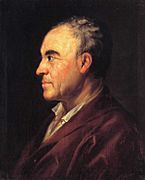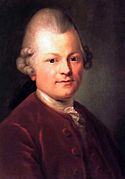Anton Graff facts for kids
Quick facts for kids
Anton Graff
|
|
|---|---|
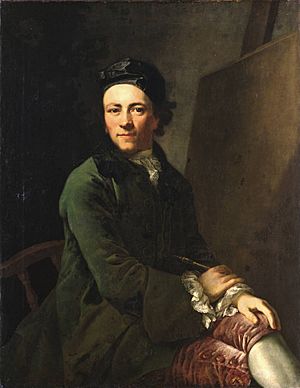
With the arrival of this self-portrait (1765) on 16 January 1766, in Dresden, Graff's career as one of the most famous portrait artists of the Neoclassicism began
|
|
| Born | 18 November 1736 Winterthur, Swiss Confederacy
|
| Died | 22 June 1813 (aged 76) |
| Nationality | Swiss |
| Education | Johann Ulrich Schellenberg, Johann Jacob Haid, Leonhard Schneider |
| Known for | Portrait Painting |
|
Notable work
|
Portrait of Frederick the Great (1781). His masterpiece |
| Movement | Neoclassicism |
| Awards | 1783: Honorary Member of the Akademie der Künste, Berlin, 1812: Honorary Member of the Academy of Fine Arts, Vienna and the Academy of Fine Arts, Munich |
| Patron(s) | Royal Courts of Prussia and Saxony |
Anton Graff (born November 18, 1736 – died June 22, 1813) was a very important Swiss portrait painter. He painted many famous people of his time. Some of them were Friedrich Schiller, Christoph Willibald Gluck, and Frederick the Great. Graff also taught art to students like Philipp Otto Runge.
Contents
Anton Graff: A Famous Painter
Anton Graff was born in Winterthur, Switzerland. He was the seventh child in his family. In 1753, he started learning to paint at an art school.
After three years, he moved to Augsburg. There, he worked with an etcher named Johann Jakob Haid. Graff was so good that other local painters worried about him. They feared he would take their jobs.
So, he had to leave Augsburg. He moved to Ansbach and worked for the court painter Leonhard Schneider. Graff often visited Munich to study paintings in different collections.
In 1765, he received an invitation. Christian Ludwig von Hagedorn, who ran the new Dresden Art Academy, wanted Graff to apply for a job. Graff was not sure if he was good enough. He sent a self-portrait to Dresden to show his talent.
The self-portrait arrived on January 16, 1766. It was very well liked! The next day, Graff was offered a job. On April 7, 1766, he arrived in Dresden. He became a court painter and a teacher at the Dresden Art Academy. He kept this job for his whole life.
Painting Famous People
Graff painted almost 1,000 portraits of people from his time. He was the best portrait painter in Germany in the late 1700s and early 1800s. He painted many German poets, including his friend Johann Wolfgang von Goethe.
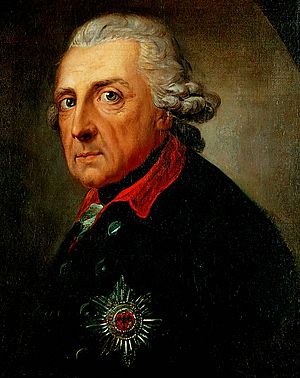
He was also a favorite painter for kings and queens. He painted Catherine the Great of Russia. He also painted Frederick the Great of Prussia. His portrait of Frederick the Great is considered his best work. You can see it at Schloss Charlottenburg.
Frederick the Great never actually posed for Graff. But Graff was allowed to watch him at a military parade in 1781. This helped Graff study the King's face and create the famous portrait.
Graff's Painting Style
Graff was popular with many different people. He painted rich landowners, diplomats, musicians, and scholars. When he painted a portrait, Graff always made sure the light shone on the person's face. This made the face the most important part of the painting. If he painted a lady, he also highlighted her décolleté.
Graff was a master of light and shadow. He learned from the artist Ján Kupecký. In his paintings, men often looked serious and quiet. He was also very good at painting clothes. He could make different fabrics and colors look natural. He learned this from the French painter Hyacinthe Rigaud.
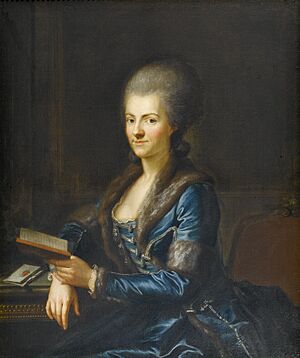
In his early years, Graff did not paint many background details. He usually kept the background one solid color. But later, he started adding more details. He often painted people outdoors, which was popular in England at the time.
Graff was very busy and earned a good living. He once said about painting Friedrich Schiller: "He cannot sit still."
Friends and Family
In 1769, Graff met Philipp Erasmus Reich, a bookseller. Reich became a good friend and asked Graff to paint his scholar friends. In 1771, Graff traveled to Berlin. He painted Gotthold Ephraim Lessing. Lessing joked about his portrait, saying, "Do I really look that terribly nice?" In Berlin, Graff also painted Moses Mendelssohn and Johann Georg Sulzer, who would become his father-in-law.
Later in his life, Graff also painted landscapes. His style of painting became very bright and lively. It even seemed to predict Impressionism. Artists like Philipp Otto Runge and Caspar David Friedrich were inspired by his work.
Graff was a friendly person. He made friends with many of the people he painted. He also had friends who were other artists. One friend was Daniel Chodowiecki, an engraver. Another was Johann Friedrich Bause, who made copies of Graff's portraits as engravings. This helped make Graff's art well-known to many people.
Graff often visited Berlin. His father-in-law introduced him to important people there. The Prussian nobility liked his work and became his good customers. Graff never forgot how well he was treated in Berlin. He once wrote, "I owe Berlin much."
On October 16, 1771, Anton Graff married Elisabetha Sophie Augusta Sulzer. They had five children. Sadly, two of their daughters died when they were very young. Their second son, Georg, died in 1801.
In 1803, Graff had eye surgery for cataracts. His wife Elisabeth died in 1812. Graff himself died from typhoid fever on June 22, 1813. He was 76 years old. He left a lot of money to his two children who were still alive. His daughter Caroline married Karl Ludwig Kaaz, who was one of Graff's students. His son Carl Anton became a landscape painter.
Graff's Legacy
Graff was a very productive artist. He created about 2,000 paintings and drawings. His paintings, especially his portraits, are still very popular today. Many of them are in museums and private collections around the world. You can find his art in Switzerland, Germany, Russia, Estonia, and Poland. He painted more portraits of men than women.
To honor Anton Graff, a school in Winterthur is named after him. There are also streets named after him in Winterthur and Dresden. In 2013, special art shows were held to celebrate his work.
Gallery
-
Friedrich Schiller. Anton Graff started the portrait in 1786. However, since Schiller could "not sit still" he only finished it in 1791. The painting was often copied. The original portrait can be seen at the "Kügelgenhaus – Museum der Dresdner Romantik" in Dresden.
-
Moses Mendelssohn (1771).
-
Self-portrait, Anton Graff and his family (1785). This painting is in the Museum Oskar Reinhart in Winterthur.
-
Gotthold Ephraim Lessing (1771).
-
George Leopold Gogel (1796). This painting is at the Hermitage Museum in Saint Petersburg.
Images for kids


